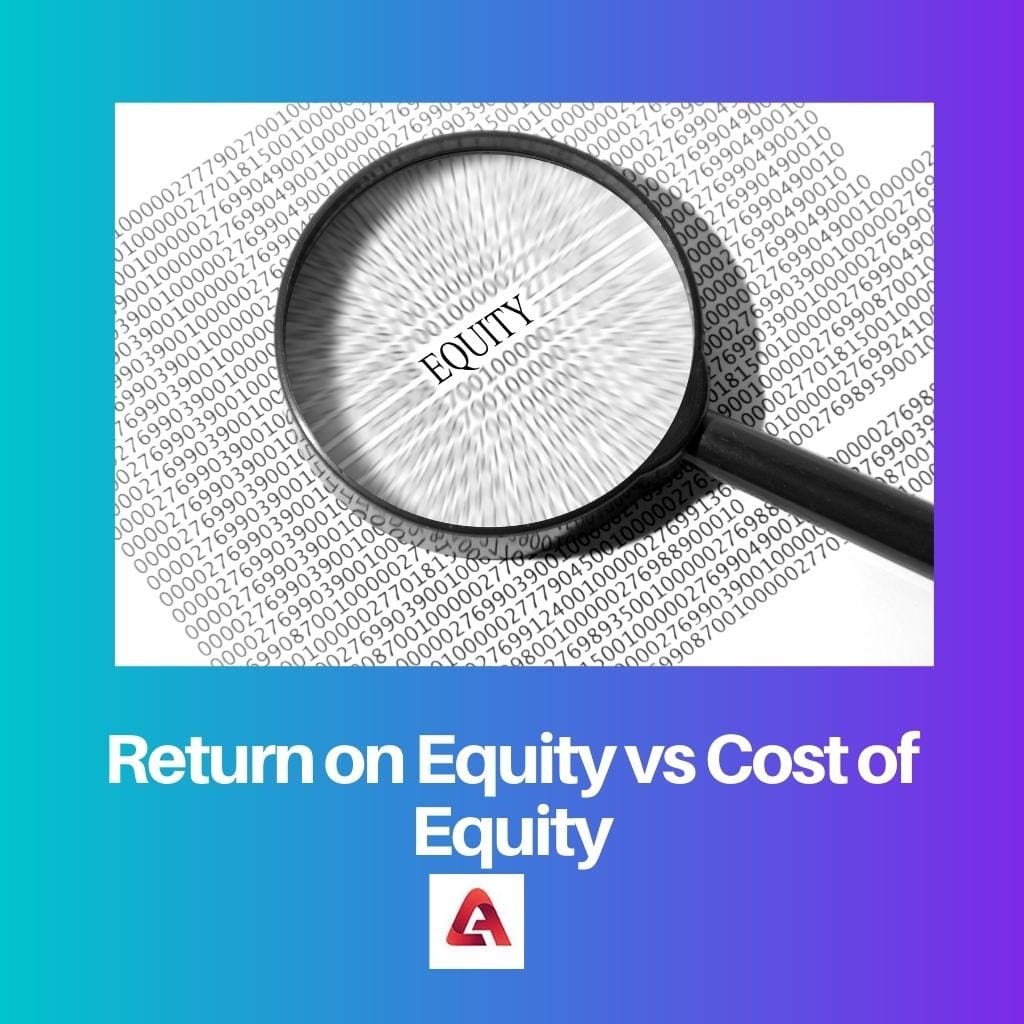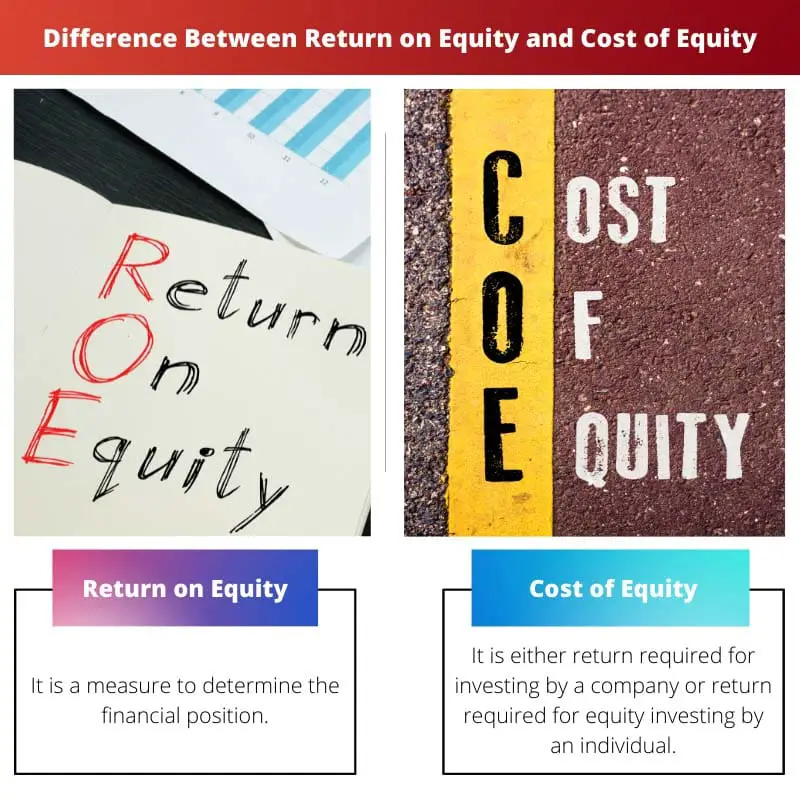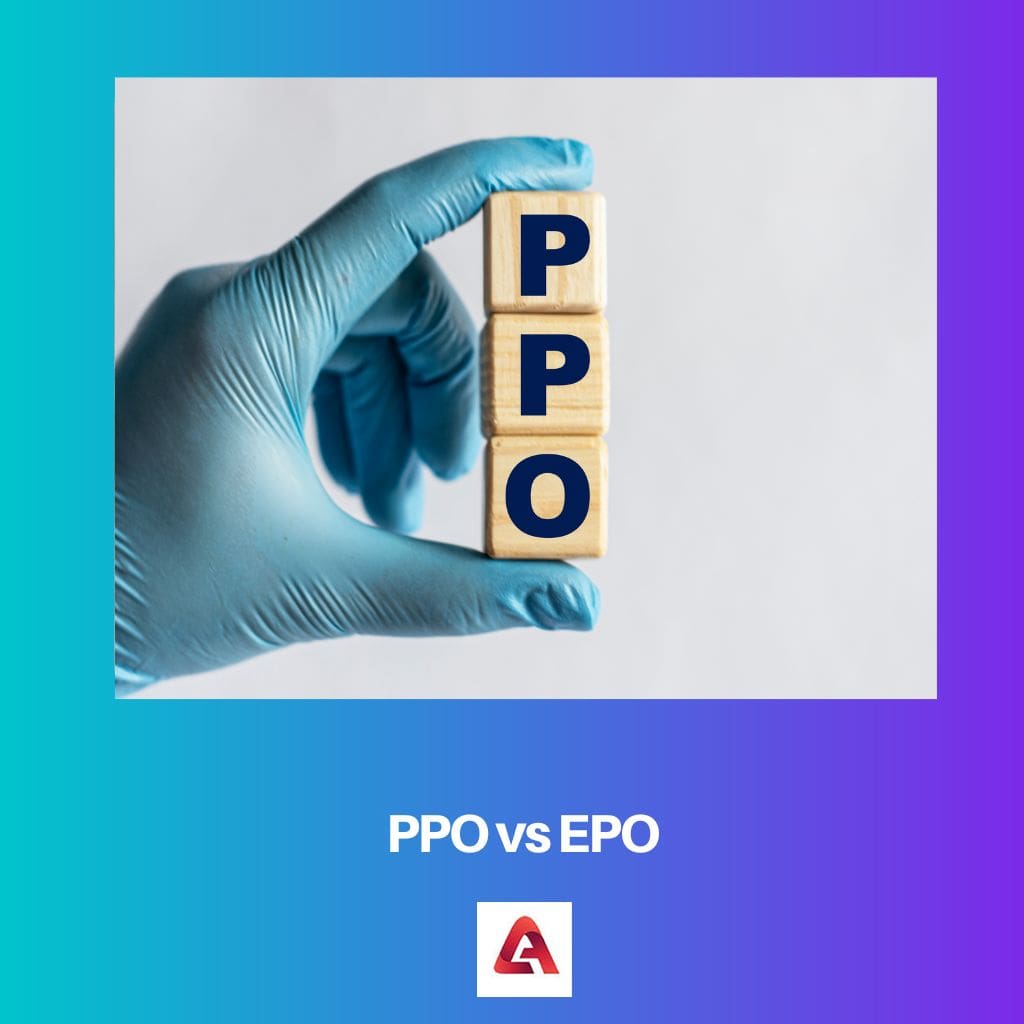Both the term Return on Equity and Cost of Equity includes Equity which is the only thing common between them, and except this, there is no similarity between them both.
Both of these have different calculation methods and importance. Along with these, they have other uses and limitations too.
Key Takeaways
- Return on Equity (ROE) is a financial metric used to calculate a company’s profitability in generating profits with shareholders’ equity.
- Cost of Equity is the return a company is expected to provide shareholders as compensation for the risks they undertake by investing in the company.
- ROE is calculated by dividing a company’s net income by its shareholder’s equity. In contrast, the Cost of Equity is determined by the company’s rate of return minus the risk-free rate.
Return on Equity vs Cost of Equity
The difference between Return on Equity and Cost of Equity is that the Cost of Equity is the return required by any company to invest or the return needed for investing in equity by any person. In contrast, the return on equity is the measure through which a company’s financial position is determined.

Return on Equity is a measure of a company’s financial position; it can be calculated for any company with one requirement. Both things required in the formula should be in positive numbers. Therefore it is calculated by dividing the company’s net income by the shareholder’s equity.
From a company’s point of view, the return required for investing or project, and from an individual point of view, the return needed to invest in equity shares is the cost of equity. Two methods are used to calculate it, the capitalization method and the capital asset pricing method.
Comparison Table
| Parameters of Comparison | Return on Equity | Cost of Equity |
|---|---|---|
| Definition | It is a measure to determine the financial position. | It is either the return required for investing by a company or the return required for equity investing by an individual. |
| Calculation | Net Income/ shareholder’s equity | Two Methods: Dividend Capitalization Method and asset pricing method. |
| Importance | Helpful in determining how much profit a company can generate from its shareholders’ investment. | Helpful in determining the value of an equity investment. |
| Use | Sustainable Growth Rate and Dividend Growth Rate. | Use to determine whether the investment is meeting the capital requirement or not. |
| Limitation | A higher Return to Equity indicates risk. | The Dividend capitalization model can only be used if the company pays dividends. |
What is Return on Equity?
Return on Equity is a method to calculate a company’s financial position.
It is used to compare the company’s performance with the market and to check whether the money invested by the shareholders is appropriately managed.
It can be calculated for any company only that the net income and equity should be positive numbers.
The formula for calculating the Return to equity is:
Net Income/Shareholders’ Equity
Return on Equity can help estimate sustainable growth and dividend growth rates.
- Sustainable Growth Rate: a model derived from ROE is used to measure the stock that may be risky and estimate the future, which is essential to be ahead of their ability.
- Dividend Growth Rate: The Payout ratio is multiplied by the ROE to measure the Dividend Growth rate.
Although high ROE is good, sometimes it can lead to risks, such as Inconsistent Profits, excess debt, and Negative Net Income.

What is Cost of Equity?
The cost of equity, for a company, is the return required for investing and, from an individual point of view, is the return necessary to invest in equity.
The primary and most important use of calculating the cost of equity is determining whether the investment meets the capital requirement, which is necessary for any company.
There are two methods by which the calculation of the cost of equity is done:
- Dividend Capitalization method: DPS is divided by the CMV, and GRD is added.
DPS: Dividends per share for next year,
CMV: current market value of stock
GRD: growth rate of dividends
- Capital asset pricing method: E(Ri) = Rf + βi * [E(Rm) – Rf]
E(Ri): Expected return on the asset I
Rf: Risk-free rate of return
βi: Beta of asset I
E(Rm): Expected market return
The only limitation Cost of Equity has is that if it is calculated with the Dividend Capitalization Method, the company must pay a dividend.

Main Differences Between Return on Equity and Cost of Equity
- Return on Equity is a measure of a company’s financial position. In contrast, in simple terms, the Cost of Equity is defined as the value of equity investment returned for an individual and the return value required for investing or a project for a company.
- Return on Equity can be calculated by simply dividing the Net Income of the company by its shareholder’s equity, whereas there are two methods for calculating the Cost of Equity; the Dividend Capitalization Method and Capital Asset Pricing Method.
- Return on Equity is essential to determine the profit company can generate from its shareholders’ investment. In contrast, the Cost of Equity is essential to know the actual value of equity investment in the capital.
- Return on Equity measures the Sustainable Growth and Dividend Growth rate using the Sustainable Growth Rate Model and Multiplying ROE with the payout ratio. In contrast, the Cost of Equity determines whether the investment meets the capital requirement.
- The limitation of Return on Equity is that the higher ROE can lead to some risks, including Inconsistent Profits, Excess Debts, and Negative Net Income. In contrast, the only limitation of the Cost of Equity is its calculation method in the Dividend Capitalization Method.





